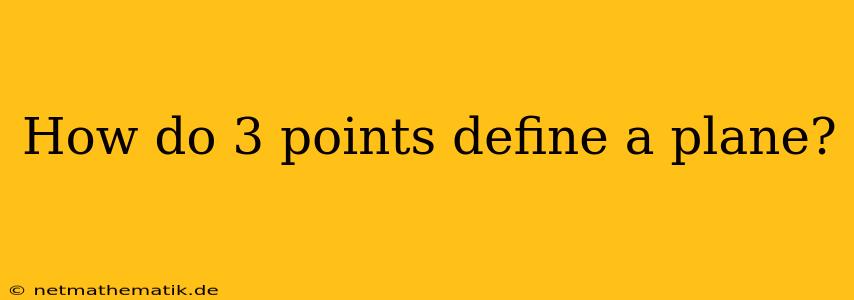In the realm of geometry, understanding the fundamental concepts is crucial for navigating complex shapes and spatial relationships. One such fundamental concept is the definition of a plane. A plane, in essence, is a flat, two-dimensional surface that extends infinitely in all directions. While it may seem simple, the question arises: how many points are needed to define a plane? The answer, remarkably, is just three. This article delves into the concept of how three points define a plane, exploring its mathematical basis, visual representations, and practical applications.
The Power of Three Points
The statement that three non-collinear points define a plane is a cornerstone of geometry. Non-collinear means that the three points do not lie on a single straight line. Imagine three points scattered randomly in space. We can connect any two of these points with a straight line. This line represents an infinite number of possible planes that could pass through it. However, the moment we introduce the third point, we introduce a constraint. This third point must lie on the same plane as the first two.
Why Three Points and Not Two?
Two points can only define a line, not a plane. Think about a line segment connecting two points. You can rotate this line segment in space, and an infinite number of planes could contain that line. Therefore, two points are insufficient to define a unique plane.
Visualizing the Concept
Visualizing this concept can be helpful. Imagine a piece of paper, representing a plane. Place three objects on the paper, ensuring they don't form a straight line. Now, imagine removing the paper. You can still visualize the plane that the objects define. They create a unique flat surface in space, even without the physical paper.
Mathematical Explanation
The concept of three points defining a plane is rooted in linear algebra. In this context, a plane can be represented as a set of points that satisfy a linear equation of the form:
ax + by + cz + d = 0
where a, b, c, and d are constants, and x, y, and z are the coordinates of any point on the plane. Given three non-collinear points, we can obtain three equations representing these points. Solving this system of three equations yields the values for a, b, c, and d, thus defining the plane.
Applications in Real World
The principle of three points defining a plane is not confined to theoretical geometry. It finds widespread application in various fields:
-
Computer Graphics: In computer graphics, objects are defined by sets of points. These points are used to create polygons that define the surfaces of the object. Three points are used to define each polygon, ensuring the object's surface is smooth and continuous.
-
Navigation Systems: GPS systems use three satellites to triangulate a user's location. Each satellite transmits a signal, and the time it takes for the signal to reach the user's receiver is used to calculate the distance between the user and the satellite. Using the distances to three satellites, the user's location can be determined using the principle of three points defining a plane.
-
Engineering and Construction: In engineering and construction, the concept of planes is used to define surfaces, such as walls, roofs, and floors. Engineers use three points to define these planes, ensuring that the structure is built correctly.
Conclusion
The concept that three points define a plane is a powerful and fundamental principle in geometry. This principle underscores the relationship between points and planes, allowing us to define and understand spatial relationships with remarkable accuracy. From the simplicity of visualizing a flat surface to its application in complex technological systems, this principle remains a cornerstone of our understanding of geometry and its applications in the real world. It serves as a reminder that even seemingly simple concepts can have profound implications in shaping our understanding of the world around us.
